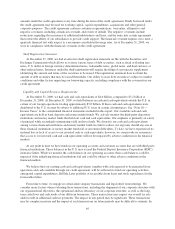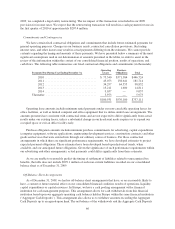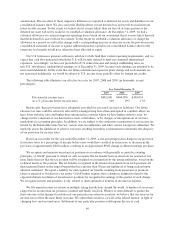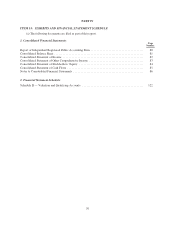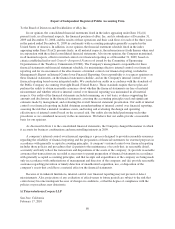eBay 2009 Annual Report Download - page 79
Download and view the complete annual report
Please find page 79 of the 2009 eBay annual report below. You can navigate through the pages in the report by either clicking on the pages listed below, or by using the keyword search tool below to find specific information within the annual report.
compensation expense recognized for 2007, 2008 and 2009 was $301.8 million, $353.3 million and
$394.8 million, respectively. See “Note 17 — Benefit Plans” to the consolidated financial statements included in
this report.
We calculated the fair value of each restricted stock award based on our stock price on the date of grant. We
calculated the fair value of each stock option award on the date of grant using the Black-Scholes option pricing
model. The determination of fair value of stock option awards on the date of grant using an option-pricing model
is affected by our stock price as well as assumptions regarding a number of highly complex and subjective
variables. The use of a Black-Scholes model requires extensive actual employee exercise behavior data and a
number of complex assumptions including expected life, expected volatility, risk-free interest rate and dividend
yield. As a result, the future stock-based compensation expense may differ from our historical amounts. The
weighted-average grant-date fair value of stock options granted during 2007, 2008 and 2009 was $10.60, $7.46
and $4.59 per share, respectively, using the Black-Scholes model with the following weighted-average
assumptions:
Year Ended December 31,
2007 2008 2009
Risk-free interest rate ........................... 4.5% 2.3% 1.7%
Expected life ................................. 3.5years 3.8 years 3.8 years
Dividend yield ................................ 0% 0% 0%
Expected volatility ............................. 37% 34% 47%
Our computation of expected volatility for 2007, 2008 and 2009 was based on a combination of historical
and market-based implied volatility from traded options on our stock. Our computation of expected life was
determined based on historical experience of similar awards, giving consideration to the contractual terms of the
stock-based awards, vesting schedules and expectations of future employee behavior. The interest rate for periods
within the contractual life of the award is based on the U.S. Treasury yield curve in effect at the time of grant.
The estimation of awards that will ultimately vest requires judgment, and to the extent actual results or updated
estimates differ from our current estimates, such amounts will be recorded as a cumulative adjustment in the
period estimates are revised. We consider many factors when estimating forfeitures, including employee class
and historical experience.
Recent Accounting Pronouncements
See “Note 1 — The Company and Summary of Significant Accounting Policies” to the consolidated
financial statements, regarding the impact of certain recent accounting pronouncements on our consolidated
financial statements.
ITEM 7A: QUANTITATIVE AND QUALITATIVE DISCLOSURES ABOUT MARKET RISK
Interest Rate Risk
The primary objective of our investment activities is to preserve principal while at the same time
maximizing yields without significantly increasing risk. To achieve this objective, we maintain our portfolio of
cash equivalents and short-term and long-term investments in a variety of securities, including government and
corporate securities and money market funds. These securities are generally classified as available for sale and
consequently are recorded on the balance sheet at fair value with unrealized gains or losses reported as a separate
component of accumulated other comprehensive income (loss), net of estimated tax. As of December 31, 2009,
approximately 63% of our total cash and investment portfolio was held in bank deposits and money market
funds. As such, changes in interest rates will impact interest income. Additionally, changes in interest rates will
impact our interest sensitive credit agreement and accordingly, impact interest expense or cost of net revenues.
As of December 31, 2009, we held no direct investments in auction rate securities, collateralized debt
obligations, structured investment vehicles or mortgaged-backed securities.
71






